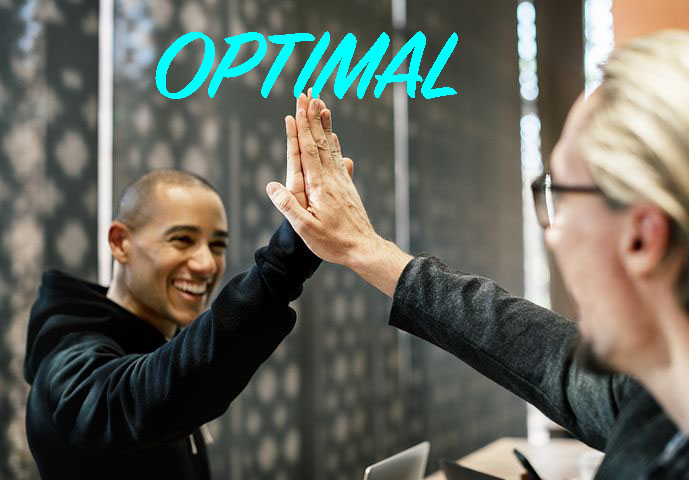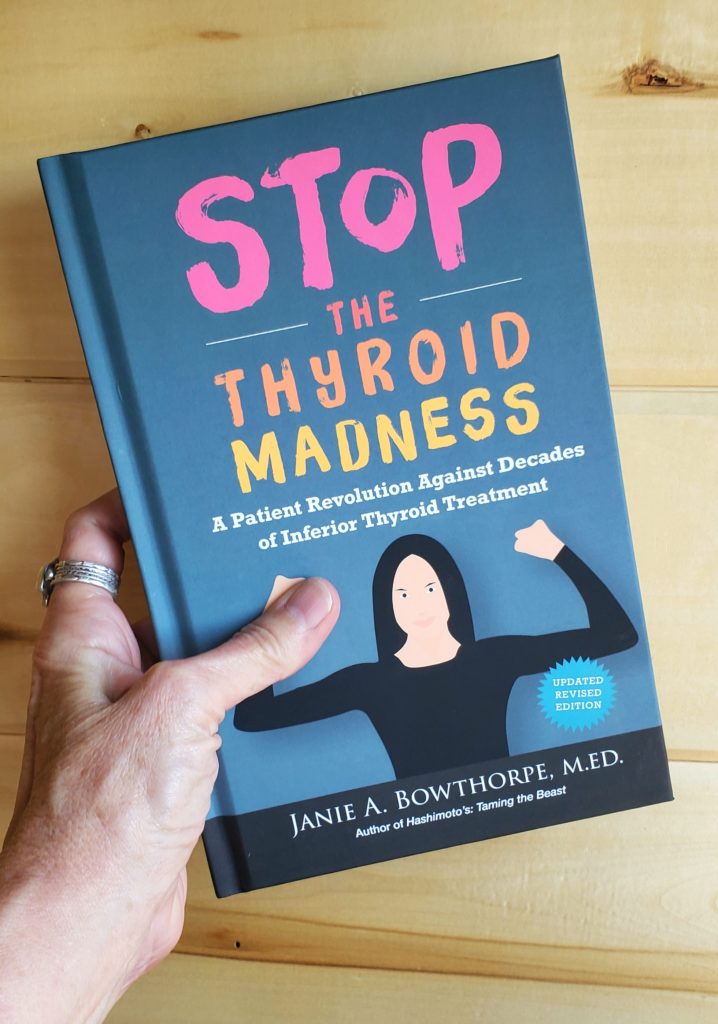OPTIMAL
op·ti·mal
The most desirable; most effective; best place to be.

I, Janie Bowthorpe, a hypo/Hashi’s patient and site creator, have been collecting over 2 decades of consistent patient-reported experiences & observations worldwide. And from that, we have learned that if our “free T3” isn’t around “optimal”, the feel-goods we achieved could eventually backfire. (mid-range isn’t optimal, even if we can feel good there). The individuality is when symptoms return. SO READ EVERY SINGLE WORD ON THIS PAGE ALL THE WAY TO THE BOTTOM. DON’T SKIM!! And attempt to teach all this to your doctor! ~Janie
NOTE: This entire page is legally copyrighted by Stop the Thyroid Madness.
So what is meant by being optimal? It’s not just referring to how you feel!
Yes, of course, we do want to feel great as hypothyroid (no matter the cause) or Hashimoto’s patients. And we want to feel great whether we have a thyroid or not. And we definitely can feel great, meaning rid of lingering or continuing symptoms of our sluggish thyroid state!
But here’s the deal: through all of our worldwide experiences over the years, we have discovered that sometimes we never achieve feeling great in our treatment. We still have pesky problems. That can happen for those on nothing but T4. Or, maybe we get to a point we do feel great, only to see an eventually backfire with a return of symptoms. What???
Let’s start with the first basic on this optimal journey: we all really do need T3 in our treatment, not just T4 as doctors are sadly taught to believe. T3 is the active thyroid hormone which changes our lives, not T4, aka thyroxine, aka levothyroxine, aka Synthroid or other names for the same thing. T4 is simply a storage hormone meant to convert to T3. But the reality is that a healthy thyroid never forces you to get T3 by conversion of T4 alone! A healthy thyroid does give you a lot of T4, but it also gives you some “direct” T3. And we have learned that we need to imitate that direct T3 fact in our treatment.
And here’s the second basic in this optimal journey: we do need to raise our thyroid meds from an initial starting dose that our doctors may give us. And we do start feeling pretty good in those raises when we achieve a midrange free T3, or just a tad over midrange. Midrange means somewhere around the middle of the provided range for the free T3. BUT…we also discovered that stopping those raises when we are around mid-range can result in a backfire, sooner or later. That means a return of our hypothyroid symptoms, and there is individuality as to when symptoms returned — it could occur in a few weeks, or a few months, or in several months, or in the 1-2 year time frame, or more. BUMMER.
So now comes the third basic in this optimal journey: we actually need to go farther up than around midrange, farther up than where we felt pretty good. We need to go up to where our free T3 is in the very upper numbers of the range!! THAT is where we are “optimal” and where it won’t backfire on us with a return of symptoms. Optimal is where we will feel great and maintain that feeling great.
Let’s go back to that midrange free T3
Now here’s another reason you do NOT want to stop with a midrange free T3, even though you may feel pretty great there: for the majority, it will eventually stress your adrenals. “Eventually” means sooner or later, your adrenals will not like you stopping there with your raises. The result?? Patients will find themselves with either 1) low cortisol, 2) high cortisol, 3) a mix of highs and lows, and/or 4) low aldosterone — another steroid adrenal hormone.
Uh oh….
Because once you have stressed your adrenals, it’s a whole new ballgame you have to treat. It turns out that being OPTIMAL better meets the varied needs of all our organs!! That’s why we don’t see a backfire if we get truly optimal, along with healthy adrenal function.
So here’s what OPTIMAL looks like (which can only be achieved with non-stressed adrenals):
- WHEN ON A TREATMENT THAT PROVIDES BOTH T4 and T3 (such as with natural desiccated thyroid (NDT) or synthetic T4 with synthetic T3): For over two decades of patient-reported observations and experiences, optimal puts the Free T3 (FT3) in the top numbers of the range (not midrange, not just above midrange), and a Free T4 (FT4) around midrange. Both, even if the FT3 is key.
- WHEN ON A TREATMENT WITH T3-ONLY (or MOSTLY T3 with only a little T4): The emphasis is solely on the free T3 being above midrange, and more specifically, in the upper numbers of the range. (The free T4 will be lower since there’s either no T4 being used, or a low amount)
But what do we do if we learn about this “optimal free T3” goal AFTER our adrenals are already stressed?
The sad thing discovered is that if we try to raise a treatment with T3 in it, in the face of either 1) high cortisol, or 2) low cortisol 3) a mix of highs and lows, or 4) low aldosterone….we can start having hyper-like symptoms, such as fast heartrate, palps, anxiety, shakiness, or any symptoms that seem “off”. No, the T3 does NOT “cause” those symptoms; it “reveals” those symptoms of stressed adrenals.
Or, we can see the free T3 going high in the blood and not getting to the cells, called pooling. Pooling is the result of not having enough cortisol to transfer T3 to the cells, as well. Aldosterone also has a small amount of cortisol. This is where patients learned over the years to lower their T3, and they figured out how to treat their adrenal issues. And this is also where you need to dig into Chapter 6 in the STTM 1 book with the blue gray cover. It has a great deal of details as to what patients learned in treating their stressed adrenal. Plus we find a doctor we can guide with the patient-to-patient information.
Other problems to be aware of and treat
1) Having a rising RT3 (reverse T3)
If we are raising a working NDT or T4/T3, and we see the RT3 (reverse T3) lab go up, we have either inadequate iron levels, inflammation or high cortisol. Any will need discovery and treatment. LOOK —> Rising RT3 will eventually start lowering our free T3.
2) Having a TSH-obsessed doctor who makes you lower your meds
As much as we like having a relationship with the doctor, this is one area we strongly have noted they are completely wrong and backwards about, i.e. it’s natural for the TSH to go very low in response to T3 in our treatment, and it does NOT cause bone or heart problems. They are confusing it with Graves’ disease (hyperthyroidism) which causes causes the latter with a low TSH. There is a complete chapter on the ridiculous TSH in the STTM 1 book.
Do I test my free’s within a few days after a raise of my thyroid meds?
If we have both T4 and T3 in our treatment, we’ve noted that it takes a few weeks to see the conversion results of T4 to T3. So testing should wait a few weeks. But if on nothing but T3, we can test the free T3 in about a week. More in the STTM 1 book.
Do I test my free’s right after taking a dose of thyroid meds?
We’ve sure learned the hard way that it’s a big NO!! That is because there is a slight rise of T4 after taking meds, and a definite high rise of T3 after taking T3-containing meds. We don’t want to test those temporary rises. We want to know what we are “hanging onto.” So we take our meds as usual one day, which usually means you are multi-dosing, then test the next morning BEFORE taking our thyroid meds for the day. (If on a T3-containing treatment, best to take it twice, or three times a day, before the next day morning test). More in the STTM 1 book.
I have an optimal Free T3 (top of range) or higher, but Free T4 is really low?
- If this is occurring when on both T4 and T3, that can be about pooling and reveals a cortisol problem. Read this.
- This can also happen if we are on a larger amount of T3 meds and a smaller amount of T4 meds. No biggie.
- If this is occurring and you are only on T3-only, that is very normal if you feel great. If you don’t feel great, it’s also about pooling. More in the STTM 1 book.
Can I get optimal on just T4-only like Levo or Synthroid?
Hardly ever, we have experienced or observed as patients for decades, except for that one, lucky, stray patient. And even when someone gets close, it’s not uncommon to still see problems, sooner or later. Sadly, there are too many life situations that can block the conversion of T4 to T3. There is a complete chapter in the STTM 1 book you need to read on the problem with T4.
Can I get optimal on a low dose of T3/low dose of a working NDT, with a lot of added T4.
Hardly ever, we have experienced. It’s puts us right back to depending mostly on conversion of T4 to T3.
I’m seeing my TSH go below range…
Even on non-optimal doses of a treatment with T3 in the mix, we have seen that it’s typical and expected to see a TSH lab result go below the range. IT’S NOT HYPERTHYROIDISM. LET ME REPEAT: our normal low TSH is NOT hyper, and it does NOT cause bone loss or heart problems. Our TSH is simply sensitive to T3 in our treatment. And it will continue being low as we make our way up to an optimal dose.
Sadly, many report they’ve had to stand firm against doctors who wrongly freak out about that normal low TSH with T3 in your treatment. Our low TSH is not the same as the low TSH seen with Graves’ disease, the hyperthyroid side of the coin that doctors confuse it with. Our low TSH when optimal with the frees does NOT cause bone loss or heart disease–it’s uncontrolled Graves’ disease (hyperthyroidism) that can do that, or still being underdosed, or having an iron or cortisol problem keeping us underdosed.
To the contrary, when we are nearing optimal with our free T3, patients have reported improved bone health via scans, and improved heart health via symptoms and tests!!
What about when I get older?? Will “optimal” levels be true when I’m much older? Will it work if I have other health issues?
We’ve seen those in their 60s,70’s and even into the 80’s report doing well with the optimal goal. But we don’t have enough feedback or experiences to know if this will be too high for everyone with an aging body with less activity. This is where if you fit this age range, it can help to find a good doctor to work with, just in case.
As far as other health issues, this is also where it’s important to work with your doctor.

<—THIS is your reference book, whether soft cover or hardbound, CHOCK FULL of important patient-to-patient information and all the ways patients got well. Includes updates and other good information based on years of patient wisdom. Throughout, the updated revision STTM book mentions “optimal” as well as more information that is crucial to getting fully well again. https://laughinggrapepublishing.com

Have autoimmune Hashimoto’s disease? —-> This is also your book with important patient-to-patient information on how to put those antibodies into remission. As a companion book to the above, Hashimoto’s: Taming the Beast has been put together in an easier to read layout–no excessively long chapters, no chit-chat or long stories. READ MORE HERE: https://laughinggrapepublishing.com
Don’t discount these life-changing books just because there is a website. There is important info in these books that won’t be covered the same way on the site. Plus, patients report getting even more from books where they can highlight, underline or bookmark the pages. One place to order is right here.
Important note: STTM is an information-only site based on what many patients worldwide have reported in their treatment and wisdom over the years. This is not to be taken as personal medical advice, nor to replace a relationship with your doctor. By reading this information-only website, you take full responsibility for what you choose to do with this website's information or outcomes. See the Disclaimer and Terms of Use.